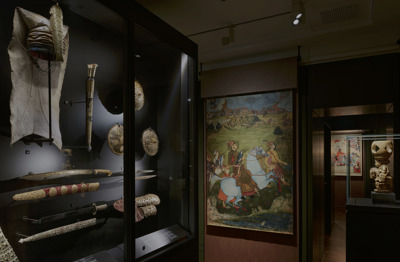Fighting, Hunting, Impressing. Arms and Armour from the Islamic World 1500 - 1850

Full of arms and armour for use in battle, when hunting and for courtly ceremonies!
We welcome visitors to enjoy the largest special exhibition ever presented here in Kronprinsessegade: Explore the fascinating arsenals of Islamic princes – full of arms and armour for use in battle, when hunting and for courtly ceremonies!
It is so fine that I don’t want to be separated from it for an instant. It is more valuable to me than all the expensive gems in the treasury. (The Indian Mughal Emperor Jahangir (r. 1605–27) about the hilt of an exquisite dagger).
The exhibition encompasses three main themes focusing on the contexts in which Islamic weapons were primarily used: for fighting, hunting and impressing others. However, the exhibition begins by shedding light on some of the other traits distinctive to Islamic arms and armour and their history: Furusiyya constitutes the chivalric code of the Islamic world: the practical education and moral edification that formed the foundation of the noble Islamic warrior. The weapons themselves often carry inscriptions, which may be quotations from the Koran believed to bring good luck – or information on who made them, who owned them, and when. The exhibition also touches on the collection history and exhibition history of the arms and armour – both in the Islamic world and in the West.
The section on fighting focuses on the practical functions associated with the battlefield. On display here are edged weapons, for example daggers, swords and curved sabres, as well as long-range weapons such as composite bows and guns. Also presented is protective equipment such as helmets, mail shirts and shields as well as objects that were used to convey messages and signals, including standards, trumpets and drums.
Hunting was a prestigious occupation for Muslim princes, which meant that quarry and other animals used during hunting were depicted in decorations on weapons, as is shown in another section.
The finest and most lavish specimens were not intended for either fighting or hunting, but may be considered a kind of male jewellery and status symbols. Accordingly, a third section is devoted to the important role played by arms and armour in more ceremonial contexts, such as audiences where rulers received their subjects, and in the exchange of gifts between the rulers and the elite, or between the rulers themselves. Vast amounts of technical skill and artistic creativity were put into the creation of these often spectacular, gem-encrusted objects, which were still fully functional weapons.
Throughout the exhibition, miniature paintings and enlargements of these provide striking testimony to the various ways in which the weapons on display were used in their own time.
The arms and armour shown were made in an area extending from North Africa in the west to India in the east. Today they are all housed in Danish collections. Objects from the David Collection have been supplemented by loans from the National Museum of Denmark, Rosenborg Castle, Designmuseum Danmark and from an extensive private collection. Many of these objects are now on display for the first time ever.
The exhibition is accompanied by a major, lavishly illustrated 296-page book comprising a number of relevant articles and a catalogue section detailing the 151 objects on display. A press release regarding the publication of the book from Strandberg Publishing can be read here. The book is available in Danish and English versions at the museum at a price of DKK 349.95.
For inquiries about the exhibition, please contact curator Joachim Meyer at [email protected] or curator Peter Wandel at [email protected].
Read the reviews (in Danish) from the Danish media here.